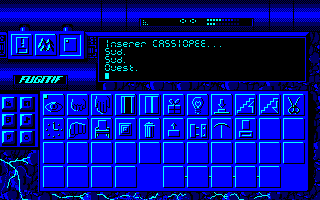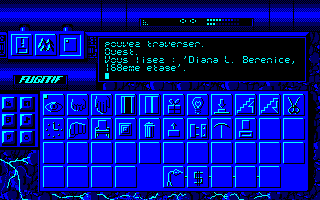Retro Replay Review
Gameplay
Fugitif: Les Aventures de Jack Bludfield – Part 1 introduces a truly distinctive icon-based interface that sets it apart from other adventure titles. Instead of typing commands or navigating complex menus, you select verbs and objects from a grid of icons overlayed on the scene you’re viewing. This system allows you to chain actions—such as picking a lock, moving a guard’s hand, or manipulating security devices—by combining multiple icons in sequence, giving you an unprecedented level of control over your environment.
(HEY YOU!! We hope you enjoy! We try not to run ads. So basically, this is a very expensive hobby running this site. Please consider joining us for updates, forums, and more. Network w/ us to make some cash or friends while retro gaming, and you can win some free retro games for posting. Okay, carry on 👍)
Movement is handled simply with the cursor keys, transitioning you from screen to screen through static, richly detailed stills. All narrative feedback and system messages appear directly on these picture screens, making it easy to track your objectives and inventory without toggling away to separate status displays. The ability to double-click verbs to reveal context-sensitive object icons streamlines complex tasks, though it can initially feel overwhelming given the large pool of 19 base objects plus situational additions that appear when the game deems them relevant.
Perhaps the most rewarding aspect of Fugitif’s gameplay is its depth of interaction. You can orchestrate elaborate sequences—knocking out a guard, transferring biometric data, and bypassing a high-security door—in a single, fluid operation. This encourages experimentation and creative problem-solving, as you’re never strictly funneled into a single “correct” solution. However, the system’s richness also demands patience: newcomers to icon-driven adventures should be prepared for a learning curve and frequent referencing of the verb-object glossary.
Graphics
Visually, Fugitif pushes the Amstrad’s high-resolution mode to its limits. Although that mode traditionally supports only four colours, clever use of interrupt programming extends the palette significantly, imbuing each scene with subtle shading and varied hues. The urban sprawl of New York’s underbelly, the cold metal corridors of the Foundation’s installations, and the barren landscapes of off-world outposts are all rendered with fine line work and striking contrasts.
The still-picture presentation lends a comic-book feel to the world, each new screen framing a fresh vignette in your pursuit of Xocann. Character and environment artwork feel hand-crafted, with careful attention to detail in everything from the glint of neon signs to the folds of Jack’s weathered trench coat. Animated sequences are minimal, but animated they don’t need to be—the game relies on your imagination to animate these static tableaux.
While the colour extension is impressive, there are occasional artefacts and palette clashes visible on some screens, a reminder of the hardware’s constraints. These minor visual glitches do little to detract from the overall aesthetic, however, and in many cases add to the gritty, worn atmosphere of a universe under the Foundation’s iron grip. For an Amstrad title, Fugitif stands out as a genuine graphical achievement.
Story
Set in a distant future where the Foundation rules the galaxy, Fugitif casts you as Jack Bludfield, a former agent turned lone bounty hunter. Your personal vendetta begins when your old partner, Xocann, escapes a high-security prison planet after having murdered Jack’s beloved and left him for dead. Driven by revenge, you follow Xocann’s trail from the neon streets of New York to unspeakable reaches of space.
The narrative unfolds methodically, with each clue you uncover revealing more about the Foundation’s shadowy operations and Xocann’s true motives. Dialogue is sparse but impactful, delivered through on-screen text that feels appropriately terse for a hard-boiled antihero tale. Interactions with informants, old colleagues, and seedy underworld figures flesh out the world, making every side character feel like part of a larger, interconnected web of intrigue.
The pacing strikes a careful balance between exploration, puzzle encounters, and story reveals. You never stray too far from your prime objective—tracking down Xocann—yet the detours into side missions and environmental storytelling add depth, making the galaxy feel lived-in. Plot twists are foreshadowed subtly, and the game’s moral ambiguity keeps you questioning whether justice and revenge can ever truly align.
Overall Experience
Fugitif: Les Aventures de Jack Bludfield – Part 1 delivers a mature, challenging adventure that rewards those willing to master its unique interface and embrace its slow-burn narrative. The icon-based system provides unparalleled flexibility, inviting players to experiment creatively, though it may intimidate anyone unaccustomed to heavy-icon Q&A mechanics. If you relish puzzles that unfold organically and aren’t afraid to dive into a detailed verb-object glossary, this game will feel like a rich playground of possibilities.
Moreover, the game’s aesthetic—static yet evocative visuals, a gritty sci-fi palette, and terse, film-noir–style writing—combines to craft an immersive world of political intrigue and personal vengeance. While occasional technical quirks betray the hardware’s age, they never overshadow the strong design sensibilities at play. Each new location and puzzle feels carefully calibrated to maintain the tension of the chase.
For fans of classic adventure games and science-fiction narratives, Fugitif offers a refreshing reinvention of familiar mechanics, spiced with a compelling story and innovative graphics for its platform. It demands patience and curiosity, but those who stick with Jack Bludfield will find themselves immersed in a futuristic odyssey of betrayal and retribution that sets the stage brilliantly for Part 2.
 Retro Replay Retro Replay gaming reviews, news, emulation, geek stuff and more!
Retro Replay Retro Replay gaming reviews, news, emulation, geek stuff and more!









Reviews
There are no reviews yet.